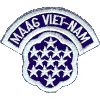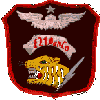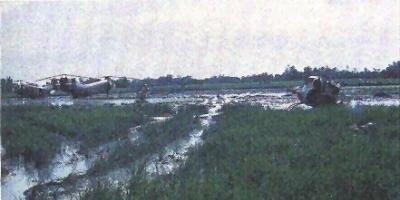Donald Leon BramanSpecialist Four93RD TRANS CO, 145TH AVN BN, MAAGV Army of the United States 01 August 1941 - 02 January 1963 Mystic, Connecticut Panel 01E Line 015 |
  
|
  
|
The database page for Donald Leon Braman
"It is better to have lived one day as a lion
A memorial from his sister, |
|
This is a "thank you" from another Donald Braman - Donald W. Braman - who served in the U.S. Marine Corps in World War II. It's apparent the name goes on, because I have just found another Donald Braman - this one a law student at Yale University . Thank you, again, for your service to our country.
Don Braman |
|
On behalf of the Braman family in Indiana, I'd like to thank you for your sacrifice.
Sandra Braman Boyles |
A Note from The Virtual WallThe 02 Jan 1963 fight at Ap Bac, a hamlet located in Kien Tuong Province southwest of Saigon, was a catastrophe from start to finish:
The ARVN were supported by American advisors and American helicopter support - the latter from the 145th Aviation Battalion's UTT Company (UH-1) and 93rd Transportation Company (CH-21). Five UH-1s acted as gunships, while the 93rd's ten CH-21s provided airlift. The MAAGV advisors could only advise - they could not command. Although the senior advisor, LTC John P. Vann, argued against the employment of forces, the ARVN commanders chose not to follow his advice. It is difficult in retrospect to second-guess either American advisors or ARVN commanders, but the fight can only be described as a VC win. Despite being grossly outnumbered and outgunned, the VC traded 18 known dead for 60+ ARVN dead and 3 Americans - and withdrew safely to the east when their position became untenable. The Americans killed at Ap Bac were
"It was a miserable damn performance" was the way one American military man summed up the humiliating and costly defeat suffered by the South Vietnamese army at the hands of outnumbered Communist guerrillas in the fight for the jungle hamlet 30 miles south of Saigon.
It was perhaps the strongest criticism by an American military adviser, but others in the battle said it was not an unfair one.
They spoke of the marked "lack of aggressiveness" of Vietnamese commanders, their refusal to heed recommendations of their American advisers, refusal to carry out orders from their superiors and a breakdown in the chain of command of the 7th Vietnamese Division.
As a result, the American sources said, the government troops suffered a needlessly high casualty toll, 65 dead and at least 100 wounded, the second highest since the war against the Communist Viet Cong began.
American advisers who took part in the battle on the edge of the Plain of Reeds recounted sorry tales of the debacle: Government forces out numbered the Communists by 10 to 1 and were supported by planes, artillery and armor.
Yet an infantry battalion located less than a mile from Ap Bac flatly refused to advance on the hamlet even though Vietnamese and American officers at division headquarters ordered and pleaded for hours. About 200 guerrillas held Ap Bac.
The battalion commander had been killed and the other officers refused to assume command. Capt. Good was killed while out in front trying to get the Vietnamese to attack.
A Vietnamese captain commanding an armored-personnel carrier company refused for 70 minutes to cross a canal to rescue downed U.S. helicopter crewmen and a company of Vietnamese infantry pinned down by small arms fire.
The captain kept complaining about "heavy enemy fire," even though U.S. advisers urged him to advance because the small arms fire could not penetrate the armored vehicles. He finally gave in to radioed orders and pleading from U.S. and Vietnamese officers and rescued most of the Vietnamese and American wounded.
Then the captain attacked twice but retreated after Communist fire kept picking off exposed machine gunners on the armored cars. U.S. advisers said the captain should have "buttoned up" the armored vehicles and run over the Viet Cong forward positions as he had been trained to do.
Most of the Communists were able to withdraw from the hamlet during the night because a paratroop battalion was dropped on the west side of the hamlet instead of the east, leaving an escape route into the jungles.
An American general narrowly escaped being killed when Vietnamese artillery accidentally shelled their own troops after the fight was over.
The advisers said American patience came to an end Friday when a civil guards company failed to move into a blocking position as ordered, leaving a U.S. Army major alone in a paddy field to face guerrilla stragglers.
Lt. Col. John Paul Vann, senior U.S. adviser with the 7th Vietnamese Division, quickly rounded up 60 American advisers, cooks and communications men from his headquarters and sent them to the aid of the major.
The Americans were under strict orders not to fire unless fired upon. They rescued the major and captured 17 guerrillas without suffering any casualties and then returned to their regular duties.
One U.S. adviser said bitterly, "These people (the Vietnamese) won't listen—they make the same mistakes over and over again in the same way."
From the |
|
The point-of-contact for this memorial is his sister, Diana Griffith kevindianagriffith@hotmail.com |
|
Top of Page
www.VirtualWall.org Back to |
With all respect
Jim Schueckler, former CW2, US Army
Ken Davis, Commander, United States Navy (Ret)
Memorial first published on 03 Dec 2001
Last updated 08/14/2007


